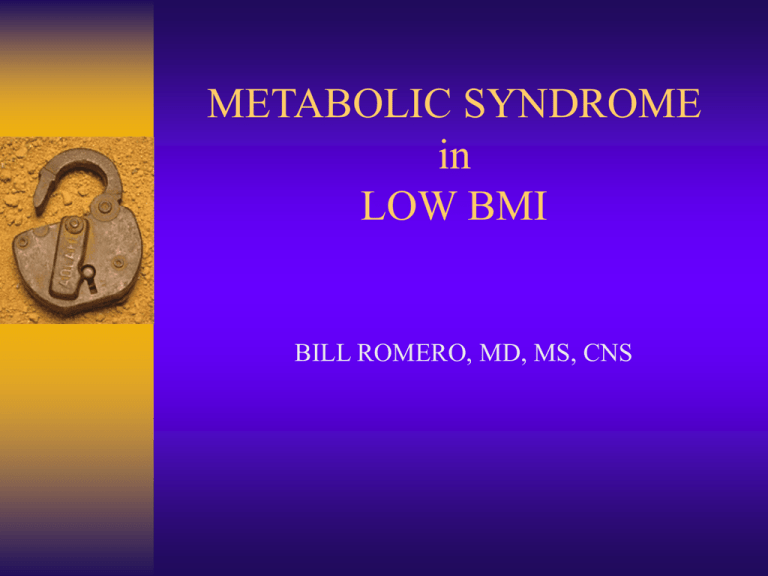Metabolic Syndrome in Low BMI
advertisement

METABOLIC SYNDROME in LOW BMI BILL ROMERO, MD, MS, CNS Body Mass Index (BMI) BMI is a weight to height ratio. The heavier the weight, relative to the same height, the higher the BMI. Estimates the fat percentage Same weight and height will have the same BMI, regardless of body fat percentage. May have normal BMI even if Body Fat % is in Obese Range (>25%). BMI Table BMI = [( lbs/inches² ) (weight in pounds X 703 )] / height in inches² BMI vs. Fat Percentage Same weight and height but varying fat percentages. Fat Percentage Most commonly measured by bio- impedance Small amount of electricity is passed through body and resistance is measured The more fat, the more resistance. Normal Weight Obesity It is possible that one can weigh “normal’ and be medically obese Normal Weight Obesity Same risk factors as “overweight” obesity Classifications: – Normal: 25% and below – Overweight: Above 25 to 29% – Obese: 30 to 40% – Morbidly Obese: Above 40% Carbohydrate Metabolism An unhealthy diet, high in refined carbohydrates, causes rapid elevation of blood sugar. The pancreas responds by increasing insulin output. Keith Vosseller, Lance Wells, M. Daniel Lane, and Gerald W. Hart Elevated nucleocytoplasmic glycosylation by O-GlcNAc results in insulin resistance associated with defects in Akt activation in 3T3-L1 adipocytes PNAS 2002; 99: 5313-5318. Insulin Resistance If the capacity of the insulin receptors is compromised due to nutrient insufficiencies and excess in sugar consumption the internal message to the cells is reduced and the efficiency of the cell is compromised. Premise Obesity causes a biochemical change: insulin resistance Insulin resistance leads to progressive weight gain (vicious cycle) Insulin resistance must be recognized and treated Proper nutrition, exercise and medications can reduce insulin resistance and reverse obesity. Metabolic Syndrome Obesity Insulin Resistance Hypertension Hyperlipidemia Prothrombotic State Proinflammatory State DIAGNOSIS Insulin Resistance – Fasting Glucose to Fasting Insulin (G:I Ratio) < 4.5 (Legro, et al) – 2-Hr Insulin 5X greater than Fasting Insulin – Fasting Insulin >20 – Elevated insulin levels in OGTT with Insulin Test – Waist to Hip Ratio Glycemic Index Ranks carbohydrates on how fast their sugar can raise glucose compared to equivalent amount of sugar. Practical Use: allows us to choose “slow-release” carbohydrates Included in Nutritional Data of food in Europe; proposed to be included in the US FOOD KCal GI Table Sugar 100 100 White Bread 100 70 Pumpernick el Bread 100 51 Fruit Pear GI 33 Apple Pineapple 45 63 Glycemic Load Compares carbohydrates on volume needed to raise blood sugar. For example, watermelon has a high glycemic index but because it is mostly water, you can eat more of it than table sugar to raise your blood sugar A GL of 20 or more is high, a GL of 11 to 19 inclusive is medium, and a GL of 10 or less is low Pharmacologic Intervention Morbid obesity with laboratory verified insulin resistance Not compliant with diet or exercise Metformin 500 mg BID or 1000 mg XR OD with meals MANAGEMENT: Dietary Three Fundamental Principles 1. Timing: Eat small meals every three hours Levels of Satisfaction >140 Stuffed 120-140 Full 90-120 Satisfaction 70-90 Hungry <70 Starving Adrenaline - shaky, irritable, hungry Cortisol – store sugar from already depleted supply Glucagon – release sugar from liver MANAGEMENT: Dietary 1. Timing: Eat every three hours regardless of hunger. Many of us do not eat enough during the day. Inadequate caloric intake during the day leads to: a. Reactive Hypoglycemia b. Nocturnal Eating Syndrome c. Central Adiposity It is self-perpetuating… MANAGEMENT: Dietary 2. Quantity: Best way to assess caloric needs is to measure Basal Metabolic Rate Rule of Thumb: Weight in pounds X 10 then add the weight. For example: 220 lbs X 10 = 2200 + 220 = 2400 To lose 1 pound a week, prescribe a diet 500 cal less than BMR. In this case, about 1800 calories. Goal: Lose 1% of weight per week. 200 lbs = 2 lbs/week Weight Reduction Prescribe Weight Reduction through Energy Deficit Select a Realistic Goal Weight 1. 2. Select a BMI 2 units below current BMI Approximate BMR BMR = Wt in lbs X 10 + Wt = (200 X 10) + 200 = 2200 Reduce BMR by 500 to 1000 calories = 1500-1800 cal 3. Use a Bio-impedance Analyzer to measure BMR BMRc BMRa 2200 1670 BMI 28 %Fat 33 MANAGEMENT: Dietary 3. Quality: Each meal must have proteins, fats and carbohydrates B S L S D 300 150 400 150 500 300 Cal 1/3 CHO 100 1/3 Prot 100 1/3 Fats 100 100 2/3 Prot & Fats 200 Choosing Foods Breakfast: 300 calories Carbohydrates (100cals) 1 sl multigrain bread 4 c salads/veggies ½ c rice, pasta, oatmeal 6 inch pita or wrap ½ c beans 1 small potato Proteins and Fats (100cals) 1 oz red meat 1-1/3 oz white meat 1 oz seafood 1 slice cheese 1 whole egg 2 eggwhites Rule of Hand Dinner should be about 500 calories Each finger = 100 Kcal 3 fingers = protein Index = complex carbohydrates Thumb = simple carbohydrates




